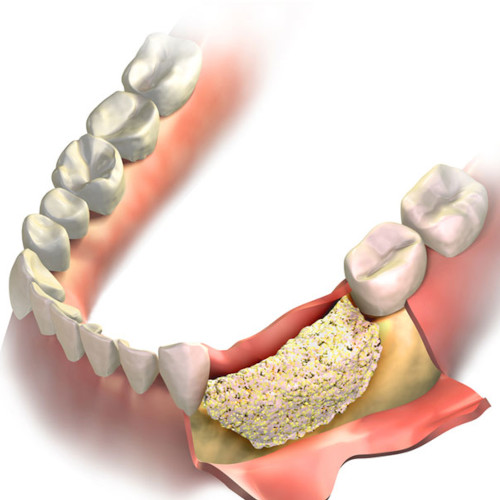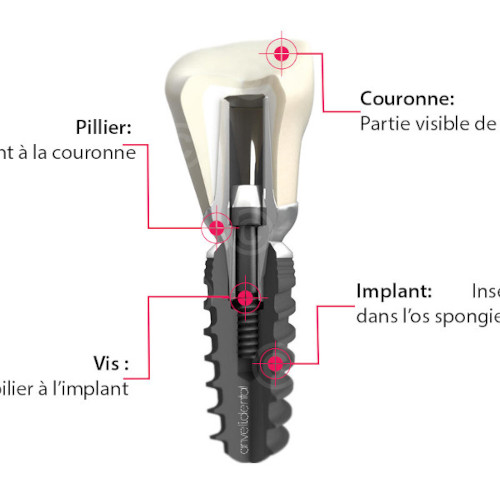Bone grafting and sinus lifts carry risks. It is essential for the dentist who performs them to inform the patient of the risks they incur. Among them we find…
Risks of sinus lift
Perforation or tearing of the sinus membrane
When the membrane detaches, perforation or tearing of the sinus membrane occurs frequently (from 11 to 56% of operations depending on the surgeon). This incident can be a point of access to colonization bacterial infection and infection. In this case, in order to mitigate this risk and depending on the size of the tear, a membrane or absorbable sutures will be placed. If the wound is too large, an ENT surgeon will have to be called in. It may be necessary to take antibiotics.
Injury of the superior-posterior alveolar nerve
This nerve is located between the lateral sinus wall and its membrane. No major consequences.
Migration of the graft into the sinus
After the surgery, especially in the first weeks, the grafted material can move up the sinuses. This displacement is encountered during sneezing. In the first weeks, it is recommended to avoid allergenic areas and certain pollutants that could cause sneezing. This is a complication that the patient should be aware of before the operation.
Wound opening
This complication occurs more rarely, mainly when the sutures have been improperly performed. The consequence is the loss of the filling material. As post-complication care, the patient will be advised not to wear his temporary prosthesis and to wear feed appropriately for 2 weeks. The wound opening often causes air to pass between the nose and mouth. Healing is difficult and can cause a sinus infection.

Sinus infection
This is the most common complication. It manifests itself by different signs: Appearance of mass on the palate and nostrils, nasal obstruction, edema, loss of cranial nerve function, pain, anesthesia or hypoaesthesia. Solution for treatment: A complete examination performed by the practitioner is necessary. Antibiotics will be prescribed (amoxicillin 3g per day for 5 days)
Appearance of an epithelial sinus cyst
Its time to onset is very variable. It varies between 6 months and 50 years. It is perfectly recognizable via a panoramic X-ray and appears in a well-defined way.
Migration of materials
Sometimes, and even after several years, the materials injected during the sinus-lift (or sinus lift) have not been integrated. During a sudden movement or a shock, they can then migrate into the sinuses causing infection and pain. Their removal may be more or less complex depending on the extent of migration and their location.
Note: Our implantology centers are focused on basal implants (Strategic implants) to avoid bone grafts in most cases. This technology requires specific clinical and laboratory equipment. Only a very small number of specialists offer this technology. Bone grafting is still possible in specific applications such as tooth replacement. If the patient still has the necessary adjacent teeth, we recommend the placement of a bridge. Bone grafting can therefore in most cases be avoided.
Risk of bone grafting
Risks during bone grafting
When going through a homogeneous material, the donor site is the jaw, the skull, the hip, or the leg. The recipient site is prepared by highlighting the site which will receive the graft. The fixation of the bone is produced by simple impaction in the case of chips or by one or more screws in the case of blocks. This screw will be removed during the placement of the dental implant. The risk is then linked to the surgical operation itself (bleeding, allergy to anesthesia, etc …)
Complications of bone augmentation
Depending on the material used, the technique used, the risks and complications are different. When using bones taken from the patient himself, complications are present on the donor and recipient areas.
Dangers of bone grafting on the donor area
The main danger during collection is hematoma or infection and abscesses requiring secondary evacuation. There is a danger when perforating the deep bone layer (on the skull) requiring special treatment. Sensitivity disturbance and persistent anesthesia are other dangers.

Complications on the grafted area
Infections and rejections from bone grafting are the main risks. And this is no small matter. This rejection can occur almost immediately after the transplant and even several years after. The consequences can be serious and lead to the death of the patient. When pain is felt in the recipient area, you must immediately contact the dentist who operated on you. The latter will perform a deep curettage in order to remove all the material present.
Rejection of bone graft materials
The main risk during a bone augmentation is the rejection of the materials to be grafted. When it comes to material taken from the patient’s body, the risk of rejection is lower. So what are these other materials that can be transplanted? More and more synthetic materials are used, but there are also bones of animal origin and even hang on … bones of human origin. Indeed, although it can be frightening, an English society uses bones from deceased people and after decontaminating the bones sells them to serve as bone grafts. This material is used more and more but patients are very rarely informed of its origin.

